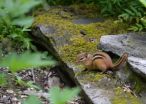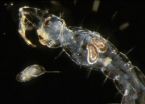(Press-News.org) Ground-nesting birds face an uphill struggle to successfully rear their young, many eggs and fledglings falling prey to predators. Now, scientists from the USA have found that some birds eavesdrop on their enemies, using this information to find safer spots to build their nests. The study – one of the first of its kind – is published this week in the British Ecological Society's Journal of Animal Ecology.
Ovenbirds and veeries both build their nests on the ground, running the risk of losing their eggs or chicks to neighbouring chipmunks. Nesting birds use a range of cues to decide where to build their nests, but Quinn Emmering and Dr Kenneth Schmidt from Texas Tech University wondered whether the 'chips', 'chucks' and 'trills' chipmunks use to communicate with each other were being eavesdropped on by the birds.
According to Emmering: "Chipmunks are vociferous, calling often during the day and sometimes joining in large choruses. We thought this might be a conspicuous cue that nesting birds could exploit."
Working in the rolling, forested hills of the Hudson Valley 85 miles north of New York City, Quinn Emmering and Dr Schmidt tested their theory that ovenbirds and veeries might be eavesdropping on chipmunks' calls before deciding where to nest by setting up a playback experiment. At 28 plots a triangular arrangement of three speakers played either chipmunk or grey tree frog calls, while at 16 'silent' control sites no recordings were played.
They found that compared with the controls, veeries and ovenbirds nested much further away from plots where chipmunk calls were played.
Interestingly the size of the response was twice as high in ovenbirds, which nested 20m further away from chipmunk-playback sites than controls, while veeries nested only 10m further away.
The weaker response by veeries suggests they may not attend to chipmunk calls as ovenbirds do. This difference could ultimately have an effect on how their respective populations are able to respond to dramatic fluctuations in rodent numbers that closely follow the boom-and-bust cycles of masting oak trees.
"We found that by eavesdropping on chipmunk calls, the birds can identify hotspots of chipmunk activity on
their breeding grounds, avoid these areas and nest instead in relatively chipmunk-free spots," says Emmering.
Veeries (Catharus fuscescens) are forest thrushes with warm, rusty-coloured backs and cream-coloured, faintly spotted chests. Ovenbirds (Seiurus aurocapilla) are larger, squat-shaped warblers. They have blotchy, dark streaks on their underside, olive above with a bold white eye-ring and an orangish crown bordered by two dark stripes.
Both ovenbirds and veeries primarily forage on the ground and low down in the shrub layer of the forest. Veeries build open, cupped-shaped nests directly on the ground or up to 1m high in shrubs. Ovenbirds, on the other hand, always nest on the ground, building dome-shaped nests made of leaves, pine needles and thatch with a side entrance. Ovenbirds are so-called because their unique nests resemble a Dutch oven where they 'cook' their eggs.
Chipmunks produce three types of calls: a high pitched 'chip', a lower pitched 'chuck' and a quieter 'trill' consisting of multiple, twittery notes. Chips and chucks are often given in a series when a predator is detected and trills are usually in response to being chased by a predator or another chipmunk.
INFORMATION:
Quinn C Emmering and Kenneth A Schmidt (2011), 'Nesting songbirds assess spatial heterogeneity of predatory chipmunks by eavesdropping on their vocalisations', doi: 10.1111/j.1365-2656.2011.01869.x, is published in the Journal of Animal Ecology on Friday 24 June 2011.
Ovenbirds eavesdrop on chipmunks to protect nests
2011-06-24
ELSE PRESS RELEASES FROM THIS DATE:
Quien es responsable cuando su hijo esta manejando el automovil que usted le presto y se ve involucrado en un accidente de transito en Nueva York?
2011-06-24
Es una historia de la que ningun padre quiere oir hablar, pero que, lamentablemente, todos hemos escuchado alguna vez. Supongamos que "Junior" pide prestado el coche y tiene un accidente. Puede ser que haya chocado simplemente contra un buzon o puede tratarse de algo mas serio. En el caso de accidentes que tengan como resultado lesiones, quien es responsable? "Junior", que solo tiene 16 anos? Sus padres? El propietario registrado del automovil?
Generalmente, de acuerdo con la ley de Vehiculos y Transito de Nueva York, cuando una persona se ve involucrada ...
Who goes there? Novel complex senses viral infection
2011-06-24
Double-stranded (ds) RNA viruses are a diverse group of viruses that include rotaviruses, a common cause of gastroenteritis. The ability of the immune system to detect and destroy viruses is critical for human health and survival. Now, a study published by Cell Press in the June 23rd issue of the journal Immunity identifies a novel sensor that is necessary to activate the immune response to viral infection. The research enhances our understanding of the complex and overlapping mechanisms our immune cells use to thwart infection.
Viruses are infectious agents composed ...
Cautionary tale for people with diabetes: Dog consumed part of a sleeping patient's toe
2011-06-24
Van Nuys, CA – June 23, 2011 – In a case study that illustrates the need for people with diabetes to be cautious of foot injuries and to protect themselves from pets, a woman with numbness in her feet caused by diabetic neuropathy slept through a traumatic episode in which her Jack Russell terrier chewed off part of her slightly infected big toe, according to an article published in this month's issue of the Journal of the American Podiatric Medical Association.
The patient's wound required surgery, and it ultimately led the amputation of her leg, leaving her a double ...
GSA Bulletin highlights: New research posted June 14, 2011
2011-06-24
Boulder, CO, USA - GSA BULLETIN offers pre-issue publication of papers online. Sign up for e-alerts at http://www.gsapubs.org/cgi/alerts or the Bulletin RSS feeds at http://gsabulletin.gsapubs.org/rss/, for first access to new journal content as it is posted.
Research highlights are provided below. Representatives of the media may obtain complimentary copies of GSA BULLETIN articles by contacting Christa Stratton at the address above. Please discuss articles of interest with the authors before publishing stories on their work, and please make reference to GSA BULLETIN ...
Scientists a step closer to understanding 'natural antifreeze' molecules
2011-06-24
Scientists have made an important step forward in their understanding of cryoprotectants – compounds that act as natural 'antifreeze' to protect drugs, food and tissues stored at sub-zero temperatures.
Researchers from the Universities of Leeds and Illinois, and Columbia University in New York, studied a particular type of cryoprotectants known as osmolytes. They found that small osmolyte molecules are better at protecting proteins than larger ones.
The findings, published in Proceedings of the National Academy of Sciences, could help scientists develop better storage ...
Finding is a feather in the cap for researchers studying birds' big, powerful eyes
2011-06-24
BETHESDA, Md., June 23, 2011 – Say what you will about bird brains, but our feathered friends sure have us -- and all the other animals on the planet -- beat in the vision department, and that has a bit to do with how their brains develop.
Consider the in-flight feats of birds of prey: They must spot their dinner from long distances and dive-bomb those moving targets at lightning speed. And then there are the owls, which operate nimbly on even the darkest nights to secure supper in swift swoops. Some birds have ultraviolet sensitivity; others have infrared sensitivity. ...
Northern Rock Adds Helpful Savings Video Guide to its Website
2011-06-24
Northern Rock has added another helpful video guide to its interactive savings website to help consumers with their savings choices.
The video - Northern Rock's Guide to Savings - is the third guide in the series recently introduced by the bank to add a further dimension to its award-winning website. Existing videos include Northern Rock's Guide to ISAs and First Time Buyers Guide, which can be viewed on the Northern Rock website alongside the new addition.
The newest guide is designed to help customers make the most of their money in an accessible way, by highlighting ...
High technology, not low taxes, may drive states' economic growth
2011-06-24
High-tech training may trump tax breaks for creating more jobs and improving a state's economy, according to a team of economists.
"We found that lower state taxes were not statistically associated with a state's economic performance," said Stephan Goetz, professor of agricultural economics and regional economics, Penn State. "The tax climate was not linked to either growth or income distribution."
Goetz, who serves as director of the Northeast Regional Center for Rural Development, said states that favor low taxes do not necessarily spend funds efficiently. They may ...
Scientists uncover an unhealthy herds hypothesis
2011-06-24
Biologists worldwide subscribe to the healthy herds hypothesis, the idea that predators can keep packs of prey healthy by removing the weak and the sick. This reduces the chance disease will wipe out the whole herd, but could it be that predators can also make prey populations more susceptible to other predators or even parasites? Biologists at the Georgia Institute of Technology have discovered at least one animal whose defenses against a predator make it a good target for one opportunistic parasite. The research appears online in the journal Functional Ecology.
"We ...
Qld fruit fly scientists in race against time
2011-06-24
Parts of Australia's fruit and vegetable industry are under threat, with Queensland University of Technology (QUT) scientists racing to find new ways to control a major horticultural pest before chemical treatments are restricted.
Associate Professor Anthony Clarke, from QUT's Faculty of Science and Technology in Brisbane, is leading Australia's largest team of university researchers examining non-chemical based ways to fight fruit flies, including promising "lure and kill" techniques using ginger essence.
Professor Clarke, lead author of the largest ever review of ...


